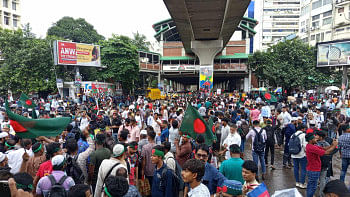Tk 179,198cr lost to natural calamites

Natural disasters like floods, drought, cyclones and river erosion have caused almost Tk 30,000 crore in damages a year between 2015 and 2020, found a first-of-its-kind government survey.
"We were once known as the land of natural disasters but we have overcome that and forged ahead," said Planning Minister MA Mannan at the launch of the survey report styled 'Bangladesh Environment Statistics 2020'.
The survey, which was conducted from 2015 to 2020 on five crore people in disaster-prone areas of 64 districts by the Bangladesh Bureau of Statistics, found direct economic losses amounting to Tk 179,198 crore.
This is equivalent to 1.32 percent of national GDP, as a result of natural disasters.
The country was able to overcome the damages by dint of people's hard work, he said, adding that he once advised the disaster-prone US state of New Orleans to consult with Bangladesh to learn how to handle natural calamities like flood and hurricanes better.
The disasters mostly degrade the land and cause damage to crops, infrastructure, livestock, fisheries, poultry and homestead forestry.
Floods caused the most damage (56 percent), followed by river or coastal erosion (14.99 percent) and cyclones. Water-logging, drought, hailstorm, salinity, landslide, thunderstorm, tornado and storms also led to economic losses.
The disasters kept people idle for 21 days on average in a year, found the study.
About 24 lakh people got sick or injured during the period, leading to medical bills amounting to Tk 3,942 crore.
Of them, about 15 lakhs were children. They were affected by diarrhoea, dysentery, skin disease, jaundice and many more.
During disasters, people have to depend on pharmacies and village doctors for treatment, the study said, adding that only 14 percent managed to get the services of MBBS doctors at that time.
The lowest income group of disaster-prone areas is 10 times more vulnerable than the top quintile in exposure to damage and loss.
As much as 97.17 percent of the bottom quintile's income vanishes for damage and loss while it is only 9.33 percent for the top quintile, it said.
However, in the same period, the knowledge and perception about climate change rose 5 percentage points since 2015, standing at 60 percent. In 2015, 38 percent did not know about climate change; that came down to 23 percent in 2020.
About 49 percent of people were getting electricity as the main source of lighting in 2015, which rose to 94 percent in 2020. The toilet facilities and safe drinking water facilities improved during the year.
When Bangladesh gained independence, the population was 7.5 crore, said Atiq Rahman, executive director of the Bangladesh Centre for Advanced Studies. Now, the population is more than 17 crore.
"We had a food crisis then. We don't have that now even though the population has more than doubled. We are in the line of self-sufficiency in food, especially in the production of lentils, paddy, rice and vegetables."
He went on to credit the hard-working and adaptive population and the local government system for the vast progress.

 For all latest news, follow The Daily Star's Google News channel.
For all latest news, follow The Daily Star's Google News channel. 



Comments